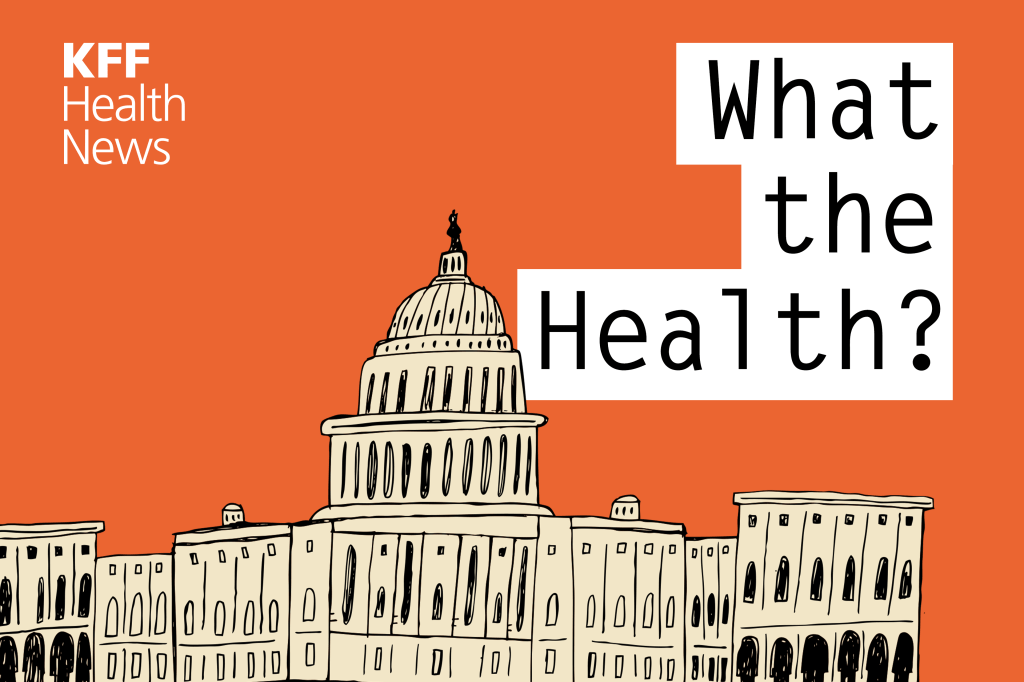KFF Health News’ ‘What the Health?’: At GOP Convention, Health Policy Is Mostly MIA

Health News tamfitronics
KFF Health News’ ‘What the Health?’
Episode Title: ‘At GOP Convention, Health Policy Is Mostly MIA’
Episode Number: 356
Published: July 18, 2024
[Editor’snote:[Editor’snote: This transcript was generated using both transcription software and a human’s light touch. It has been edited for style and clarity.]
Julie Rovner: Hello, and welcome back to “What the Health?” I’m Julie Rovner, chief Washington correspondent for KFF Health News, and I’m joined by some of the best and smartest health reporters in Washington. We’re taping this week on Thursday, July 18, at 10 a.m. As always, news happens fast and things might’ve changed by the time you hear this. So, here we go.
We are joined today via video conference by Alice Miranda Ollstein, of Politico.
Alice Miranda Ollstein: Good morning.
Rovner: Sarah Karlin-Smith at the Pink Sheet.
Sarah Karlin-Smith: Hi, everybody.
Rovner: And Joanne Kenen of the Johns Hopkins Schools of public health and nursing, and Politico Magazine.
Joanne From: Hi, everybody.
Rovner: Later in this episode, we’ll have my interview with KFF Health News’ Renuka Rayasam, about the latest “Bill of the Month.” This month’s patient went to a facility with urgent care in its name but then got charged emergency room prices. But first, this week’s news.
So as of this morning, we are most of the way through the Republican National Convention, which obviously has a somewhat different tone than was expected, following last weekend’s assassination attempt on former President Donald Trump. The big news of the week is Trump’s selection of Ohio Republican Sen. JD Vance as his running mate. Vance has only been in the Senate since 2023, had not served previously in public office, and he doesn’t have much of a record on much of anything in health care. So, what do we know about what he thinks?
Ollstein: Well, I have been most focused on his abortion record, which is somewhat more extensive than his record on other health policy. Obviously, Congress has not done very much on abortion, but he’s been loud and proud about his anti-abortion views, including calling for national restrictions. He calls it a national minimum standard, but the idea is that he does not want people in conservative states where abortion is banned to be able to travel to progressive states where it is allowed. He has given interviews to that effect. He has signed letters to that effect. He has called for enforcement of the Comstock Act, which, as we’ve talked about before, is this long dormant statute that prohibits the mailing of abortion drugs or medical instruments that could be used to terminate a pregnancy. And so this is a very interesting moment to pick Vance.
The Republican Party is attempting to reach out to more moderate voters and convince them that they are hoping to leave this issue to the states. Vance’s record somewhat says otherwise. He also opposed efforts in his own state of Ohio to hold a referendum that ended up striking down that state’s abortion ban. So, definitely a lot for Democrats to go after in his record and they are not wasting any time; they are already doing it.
Rovner: Yeah, I’m kind of surprised because Vance, very much like Trump, has been kind of everywhere, or at least he has said that he’s kind of everywhere on abortion. But as you mentioned, Alice, you don’t have to look very hard to see that he’s pretty doctrinaire on the issue. Do you think people are going to buy this newer, softer Republicanism on abortion?
Ollstein: Well, abortion rights groups that I’ve spoken to are worried that people are buying it. They’re worried as they campaign around the country that the Republican Party’s attempt to walk away from their past calls for national restrictions on abortion are breaking through to people. And so they are trying really hard to counter that message and to stress that Republicans can and would pursue national restrictions, if elected.
I think both Democratic candidates and abortion rights groups are working to say even the leave-it-to-states position is too extreme and is harming people. And so they’re lifting up the stories of people in Texas and other states with bans who have experienced severe medical harm as a result of being denied an abortion. And so they’re lifting up those stories to say, “Hey, even saying let’s leave it to the states, let’s not do a national ban — even that is unacceptable in the eyes of the left.”
Whose: The other issue obviously with his life story is opioids. His mother was addicted. Originally it began with being prescribed a legal painkiller. It’s a familiar story: became addicted, he was raised by his grandmother. His mother, who he showed on TV last night and she was either in tears or really close to tears, she’s 10 years sober now. He had a tough life and opioids was part of the reason he had a tough life. And whatever you think of his politics, that particular element of his life story resonates with people because it may explain some of his political views. But that experience is not a partisan experience and he was a kid. So I think he clearly does see opioids as a medical problem, not just, oh, let’s throw them in jail. I mean, the country and the Republican Party, that has been a change. It’s not a change that’s completed, but that shift is across party lines as well. That’s part of him that — it’s something you listen to when he tells that story.
I mean also, he told a story about his grandmother late in life, the grandmother who raised him, having, when she died, they found 19 handguns in the house all over the place. And he told sort of a funny story that she was old and frail and she always wanted to have one within reach. And all I could think of is, all these unlocked handguns with kids in the house! I mean, which is not a regulatory issue, but there’s a gun safety issue there. I’m just thinking, oh my God, 19 guns in drawers all over the house. But he’s obviously a very, the Republican Party is … I mean, after the assassination attempt, you have not heard Donald Trump say, “Maybe I need to rethink my position on gun control.” I mean, that’s not part of the dialogue right now.
I think having someone with that experience, talking about it the way he does, is a positive thing, really. Saying, “Here’s what we went through. Here’s why. Here’s how awful it was. Here’s how difficult it was to get out of it. And this is what these families need.” I mean, that is …
Rovner: Although it’s a little bit ironic because he’s very anti-social programs, in general.
Karlin-Smith: And he’s had a bad track record of trying to address the opioid crisis. He had a charity he started that he ended I guess about when he was running for Senate that really was deemed nonsuccessful. It also had questionable ties to Purdue Pharma, that’s sort of responsible for the opioid crisis. And the other thing that you sometimes hear in both him and Trump’s rhetoric is the blaming of immigrants and the drug cartels and all of that stuff for the opioid crisis. So, there’s a little bit of use of the topic, I think, to drop anti-immigrant sentiment and not really think about how to address the actual health struggles.
Whose: When he talks about his family, he’s not saying China sent my mother fentanyl. I think it is good for people to hear stories from the perspective of a family who had this, as it is a health problem, reminding people that this is not thugs on the street shooting heroin. It’s a substance abuse disorder, it’s a disease. And so I think the country has come a long way, but it isn’t where it needs to be in terms of understanding that it’s a behavioral health problem. So I think in that sense he will probably be a reminder of that. But he doesn’t have a health record. I mean, he wasn’t there during the Obamacare wars. We don’t really know what he thinks about. I’m not aware of anything he’s really said about entitlements and Medicare. He does come from the state … I mean, Trump is saying he won’t touch it. But I mean if he said Medicare stuff, I missed it. I mean, if one of you knows, correct …
Karlin-Smith: Well, he has actually said that he supports Medicare drug price negotiation at times, which is interesting and unique for a Republican. And I mean Trump, as well, has been a bit different from the traditional Republican, I think, when it comes to the pharma industry and stuff, but I think that maybe is even a bridge too far in some ways.
Rovner: Yeah, he’s generally pretty anti-social program, so it’ll be interesting to see how he walks that line.
Well, this is all good segue into my next question, which is, health in general has been mostly MIA during this convention, including any update on Trump’s ear injury from the attempted assassination. Are we finally post-repeal-and-replace in the Republican Party? Or is this just one of those things that they don’t want to talk about but might yet take up if they get into office?
Whose: We don’t know what the balance of power is in the Senate and the House, right? I mean, that’s probably going to be part of it. I mean, if they have huge … if they capture both chambers with huge majorities, it’s a new ballgame. Whether they actually try to repeal it, versus there’s all sorts of ways they can undermine it. Trump did not succeed in repealing it. Trump and the House Republicans did not, the Republicans in general did not succeed in repealing it, despite a lot of effort. But they did undermine it in all sorts of ways and coverage actually fell during the Trump administration. ACA [Affordable Care Act] coverage did drop; it didn’t vanish completely, but it dropped. And under Biden it continued to grow. Now, the Republicans get their health care through the ACA, so it’s become much more normalized, but we don’t know what they will do. Trump is not a predictable politician, right? I mean, he often made a big deal about trying to lower drug prices early in his term, and then nothing. And then he even released huge, long list of things …
I remember one of our reporters — Sarah and I were both … Sarah, Alice, and I were all at Politico — and I think it was David who counted the number of question marks in that report. And at the end of the day, nothing much happened. I don’t think the ACA is untouchable; it may or may not be unrepealable in its entirety, but it’s certainly not untouchable.
Rovner: Well, he also changes positions on a whim, as we’ve seen. Most politicians you can at least count on to, when they take a position, to keep it at least for a matter of days or weeks, and Trump sometimes in the same interview can sort of contradict himself, as we know. But I mean, obviously a quick way to undermine the ACA, as you say, would just be to let the extended subsidies expire because they would need to be re-upped if that’s going to continue and there are many millions of people that are now …
Whose: And they expire next year.
Rovner: … Yes, that are …
Whose: And there are also two other things. You cut the navigating budget. You cut advertising. You don’t try to sell it. I don’t mean literally sell it, but you don’t try to go out and urge … I mean, that was their playbook last time, and that’s why — it’s one reason enrollment dropped. And that was, the subsidies were under Biden, the extended subsidies. So that’s one year away.
Ollstein: But it’s no surprise that this hasn’t been a big topic of discussion at the RNC [Republican National Convention]. I mean, polling shows that voters trust Democrats more on health care; it’s one of their best issues. It’s not a good issue for Republicans. And so it was fully expected that they would stick to things that are more favorable to them: crime, inflation, whatnot. So, I do expect to hear a lot about health care at the DNC [Democratic National Convention] in a few weeks. But beyond that, we do not know what’s going to happen at the DNC.
Rovner: Yeah.
Karlin-Smith: I was going to say, the one health issue we haven’t really touched on, which the Republicans have been hammering on, is transgender health care and pushing limits on it, especially for people transitioning, children, and adolescents. And I think that’s clearly been a strategic move, particularly as they’ve gotten into more political trouble with abortion and women in the party. They clearly seem to think that the transgender issue, in general, appeals more to their base and it’s less risky for them.
Rovner: Their culture warrior base, as you will. Yeah, and we have in fact seen a fair bit of that. Well, before we leave the convention, one more item: It seems that Trump and RFK Jr. [independent presidential candidate Robert F. Kennedy Jr.] had a phone conversation, which of course leaked to the public, during which they talked about vaccine resistance. Now we know that RFK Jr. is a longtime anti-vaxxer. What, if anything, does the recounting of this conversation suggest about former President Trump’s vaccine views? And we’ve talked about this a little bit before, he’s been very antimandate for the covid vaccine, but it’s been a little bit of a blank on basic childhood vaccines.
Karlin-Smith: And I mean, his remarks are, they’re almost a little bit difficult to parse, they don’t quite make sense, but they seem to be essentially repeating anti-vax tropes around, well, maybe one vaccine on their own isn’t dangerous, but we give kids too many vaccines at a time or too close together. And all of that stuff has been debunked over the years as incorrect. The vaccine schedule has been rigorously evaluated for safety and efficacy and so forth.
That said, Trump obviously was in office when we spearheaded the development of covid vaccines, which ended up being wildly successful, and he didn’t really undermine that process, I guess, for the most part when he was in office. So it’s hard to know. Again, there’s a lot of difficulty in predicting what Trump will actually do and it may depend a lot who he surrounds himself with and who he appoints to key positions in his health department and what their views are. Because he seems like he can be easily persuaded and right now he may just be in, again, campaign mode, very much trying to appeal to a certain population. And you could easily see him — because he doesn’t seem to care about switching positions — just pivoting and being slightly less anti-vax. But it’s certainly concerning to people who have been even more about the U.S. anti-vax sentiments since covid and decreases in vaccination rates.
Rovner: It did feel like he was trying to say what he thought RFK Jr. wanted to hear, so as to win his endorsement, which we know that Trump is very good at doing. He channels what he says depending on who he’s talking to, which is what a lot of politicians do. He just tends to do it more obviously than many others.
Whose: Julie, we heard this at the tail end of the 2016 campaign. He made a few comments, exactly, very, very similar to this, the size of a horse vaccine and you see the changes — there’s too many, too many vaccines, too large doses. We heard this briefly in the late 2016, and we heard it at the very — I no longer remember whether it was during transition in 2016 or whether it was early in 2017 when he was in the White House — but we heard a little bit of this then, too. And he had a meeting with RFK then. And RFK said that Trump was talking about maybe setting up a commission and RFK at one point said that Trump had asked him to head the commission. We don’t think that was necessarily the case.
First of all, there was no commission. The White House never confirmed that they had asked RFK to lead it. Who knows who said what in a closed room, or who heard what or what they wanted to hear; we don’t know. But we heard this whole episode, including Trump and RFK, at approximately the beginning of 2017, and it did go away. Covid didn’t happen right away; covid was later. There was no anti-vax commission. There was no vax commission. There was no change in vaccination policy in those early years prepandemic. And as Sarah just pointed out, Trump was incredibly pro-vaccine during the pandemic. I mean, the Operation Warp Speed was hailed by even people who didn’t like anything else about Trump. When public health liked Operation Warp Speed, he got vaccines into arms fast, faster than many of us thought, right?
The difference — there were anti-vaxxers then; there have been since smallpox — but it is much more politicized and much more prominent, and in some ways it has almost replaced the ACA as your identifying health issue. If you talk to somebody about the ACA, you know what party they are, you even know where within the party they are, what wing. And that’s not 100% true of anti-vaxxers. There are anti-vaxxers on both sides, but the politicization has been on the Republican-medical-libertarian side, that you-can’t-tell-me-what-to-do-it’s-my-body side. It is much more part of his base and a more intense, visible, and vocal part of his base. So, it’s the same comments, or very similar comments, to the same person in a different political context.
Rovner: Well, I think it’s safe to say that abortion does remain the most potent political health issue of the year, and there was lots of state-based abortion election news this week. As we’ve been discussing all year, as many as a dozen states will have abortion questions on the ballot for voters this November, but not without a fight. Florida has just added an addendum to its ballot measures, suggesting that if passed, it could cost the state money. And in Arkansas and Montana, there are now legal fights over which signatures should or shouldn’t be counted in getting some of those questions to the ballot.
Alice, in every state that’s voted on abortion since Dobbs [[v. Jackson Women’s Health Organization], the abortion-right side has prevailed. Is the strategy here to try to prevent people from voting in the first place?
Ollstein: Oh, yes. I wrote a story about this in January. It’s been true for a while, and it’s been true in the states that already had their votes, too. There were efforts in Ohio to make a vote harder or to block it entirely. There were efforts in Michigan to do so. And even the same tactics are being repeated. And so the fight over the cost estimate in Florida, which is usually just a very boring, bureaucratic, routine thing, has become this political fight. And that also happened in Missouri. So, we’re seeing these trends and patterns and basically any aspect of this process that can be mobilized to become a fight between conservative state officials and these groups that are attempting to get these measures on the ballot, it has been. And so Arizona is also having a fight over the language that is going to go in the voter guide that goes out to everybody. So there’s a fight going on there that’s going to go to court next week about whether it says fetus or unborn child. So, all of these little aspects of it, there’s going to be more lawsuits over signature, validation, and so it’s going to be a knockdown, drag-out fight to the end.
It’s been really interesting to see that conservative efforts to mount these so-called decline-to-sign campaigns, where they go out and try to just convince people not to sign the petition — those have completely failed, even in states that haven’t gotten the kind of national support and funding that Florida and Nevada and some of these states have. Even those places have met their signature goals and so they’re now moving to this next phase of the fight, which is these legal and bureaucratic challenges.
Rovner: This is going to play out, I suspect, right, almost until the last minute, in terms of getting some of these on the ballot.
Meanwhile, here on Capitol Hill, there’s an effort underway by some abortion rights backers to repeal the 1873 Comstock Act, which some anti-abortion activists say could be used to establish a national abortion ban. On the one hand, repealing the law would take away that possibility. On the other hand, suggesting that it needs to be repealed undercuts the Biden administration’s contention that the law is currently unenforceable. This seemed to be a pretty risky proposition for abortion rights forces no matter which way they go, right?
Ollstein: Well, for a while, the theory on the abortion rights side was, oh, we shouldn’t draw attention to Comstock because we don’t want to give the right the idea of using it to make a backdoor abortion ban. But that doesn’t really hold water anymore because they clearly know about it and they clearly have the idea already and are open about their desire to use it in documents like Project 2025, in letters from lawmakers urging enforcement of the Comstock Act. And so the whole …
Rovner: In concurring opinions in Supreme Court cases.
Ollstein: … Exactly, exactly. In legal filings in Supreme Court cases from the plaintiffs. So clearly, the whole “don’t give the right the idea thing” is not really the strategy anymore; the right already has the idea. And so now I think it’s more like you said, about undercutting the legal argument that it is not enforceable anyway. But those who do advocate for its repeal say, “Why wouldn’t we take this tool out of contention?” But this is sort of a philosophical fight because they don’t have the votes to repeal it anyway.
Rovner: Yeah, though I think the idea is if you bring it up you put Republicans on the record, as …
Ollstein: Sure, but they’ve been doing that on so many things. I mean, they’ve been doing that on IVF [in vitro fertilization]they’ve been doing that on contraception, they’ve been doing that on abortion, they’ve been doing it on the right to travel for an abortion. They’ve been doing it over and over and over and I don’t see a lot of evidence that it’s making a big impact in the election. I could be wrong, but I think that’s the current state of things.
Rovner: Yeah, I’m with you on that one.
All right, well, while we are all busy living our lives and talking about politics, covid is making its now annual summer comeback. President Biden is currently quarantining at his beach house in Rehoboth after testing positive. HHS [Department of Health and Human Services] Secretary Xavier Becerra was diagnosed earlier this week. And wastewater testing shows covid levels are “very high” in seven states, including big ones like Florida, Texas, and California. Sarah, do we just not care anymore? Is this just not news?
Karlin-Smith: Probably, it depends on who you ask, right? But I think obviously with Biden getting covid, it’s going to get more attention again. I think that a lot of health officials, including in the Biden administration, spent a lot of time trying to maybe optimistically hope that covid was going to become a seasonal struggle, much like flu, where we really sort of know a more defined risk period in the winter and that helps us manage it a bit. And always sort of seemed a little bit more optimistic than reality. And I think recently I’ve listened to some CDC [Centers for Disease Control and Prevention] meetings and stuff where — it’s not really, it’s a little bit subtle — but I think they’re finally kind of coming around to, oh wait, actually this is something where we probably are going to have these two peaks every year. They’re sort of year-round risk. But there hasn’t been a ton done to actually think through, OK, what does that mean for how we handle it?
In this country, every year they have been approving a second vaccine for the people most at risk, although uptake of that is incredibly low. So it does seem like it’s become a little bit of a neglected public health crisis. And certainly in the news sometimes when something kind of stays at this sort of constant level of problem, but nothing changes, it can sometimes, I think, be harder for news outlets to figure out how to draw attention to it.
Rovner: It does seem like, I mean, most of the prominent people who have been getting it have been getting mild cases. I imagine that that sort of has something to do … We’re not seeing … even Biden, who’s as we all know, 81, is quarantining at his beach house, so.
Karlin-Smith: Right, I mean, if you kind of stay up to date, as the terminology is, on your vaccinations, you don’t have a lot of high -risk conditions, if you are in certain at-risk groups you get Paxlovid. For the most part a lot of people are doing well. But that said, I think, I’m afraid to say the numbers, but if you look up the amount of deaths per week and so forth, it’s still quite high. We’re still losing — again, more people are still dying from covid every year, quite a few more than from the flu. I mean, one thing I think people have also pointed out is when new babies are born, you can’t get vaccinated until you’re 6 months. The under-6-month population has been impacted quite a bit again. So, it is that tension. And we saw it with the flu before covid, which is every year flu is actually a very big issue in the U.S. and the public health world for hospitals and stuff but the U.S. never quite put enough maybe attention or pressure to figure out how to actually change that dynamic and get better flu vaccine uptake and so forth.
Whose: And the intense heat makes it, I mean — covid is much, much, much, much more transmissible inside than outside. And the intense heat — we’re not sitting around enjoying warm weather, we’re inside hiding from sweltering weather. We’re all in Washington or the Washington area, and it’s been hot with a capital H for weeks here, weeks. So people are inside. They can’t even be outside in the evening, it’s still hot. So we think of winter as being the indoors time in most of the country, and summer sort of the indoors time in only certain states. But right now we are in more transmissible environments for covid and …
Rovner: Meanwhile, while we’re all trying to ignore covid, we have bird flu that seems to be getting more and more serious, although people seem to just not want to think about it. We’re looking at obviously in many states bird flu spreading to dairy cows and therefore spreading to dairy workers. Sarah, we don’t really even know how big this problem is, right? Because we’re not really looking for it?
Karlin-Smith: That seems to be one of the biggest concerns of people in the public health-virology community who are criticizing the current response right now, is just we’re not testing enough, both in terms of animal populations that could be impacted and then the people that work or live closely by these animal populations, to figure out how this virus is spreading, how many people are actually impacted. Is the genetics of the virus changing? And the problem of course then is, if you don’t do this tracking, there’s a sense that we can get ourselves in a situation where it’s too late. By the time we realize something is wrong, it’s going to already be a very dangerous situation.
Rovner: Yeah, I mean, before covid, the big concern about a pandemic was bird flu. And was bird flu jumping from birds to other animals to humans, which is exactly what we’re seeing even though we’re not seeing a ton of it yet.
Whose: We’re not seeing a ton of it, and in its current form, to the best of our knowledge, it’s not that dangerous. The fear is the more species it’s in and the more people it’s in, the more opportunities it has to become more dangerous. So, just because people have not become seriously ill, which is great, but it doesn’t mean it stays great, we just don’t — Sarah knows more about this than I do, but the flu virus mutates very easily. It combines with other flu viruses. That’s why you hear about Type A and Type B and all that. I mean, it’s not a stable virus and that is not, I’m not sure if stable is the right …
Rovner: It’s why we need a different flu shot every year.
Whose: Right, and the flu shots we have, bird flu is different.
Rovner: Well, we will continue to watch that.
Whose: Sarah can correct anything I just got wrong. But I think the gist was right, right?
Rovner: Sarah is nodding.
All right, well finally, one follow up from last week in the wake of the report from the Federal Trade Commission on self-dealing by pharmacy benefits managers: We get a piece from The Wall Street Journal this week[“[“Mail-Order Drugs Were Supposed To Keep Costs Down. It’s Doing the Opposite.”]documenting how much more mail-order pharmacies, particularly mail-order pharmacies owned by said PBMs [pharmacy benefit managers] are charging. Quoting from the story, “Branded drugs filled by mail were marked up on average three to six times higher than the cost of medicines dispensed by chain and grocery-store pharmacies, and roughly 35 times higher than those filled by independent pharmacies.” That’s according to the study commissioned by the Washington State Pharmacy Association. It’s not been a great month for the PBM industry. Sarah, I’m going to ask you what I asked the panel last week: Is Congress finally ready to do something?
Karlin-Smith: It seemed like Congress has finally been ready to do something for a while. Certainly, both sides have passed legislation and committees and so forth, and it’s been pretty bipartisan. So we’ll see. I think some of it costs — I forget if some of it costs a little money — but some of it does save. And that’s always an issue. And we know that Congress is just not very good at passing stand-alone bills on particular topics, so I think the key times will be to look at when we get to any big end-of-year funding deals and that sort of thing, depending on all the dynamics with the election and the lame duck, but …
Rovner: I mean, this has been so bipartisan. I mean, there’s bipartisan irritation in both houses, in both parties.
Karlin-Smith: Right, and I think the antitrust sort of element of this with PBMs kind of appeals to the Republican side of the aisle quite a bit. And that’s why there’s always been a bit of bipartisan interest. And the question becomes: PBMs sort of fill the role that in other countries government price negotiators fill. And that’s not particularly popular in the U.S., particularly on the Republican side of the aisle. And so most of the legislation that is pending, I think, will maybe hopefully get us to some transparency solutions, tweak some things around the edges, but it’s not really going to solve the crisis. It’s going to be, I mean, a very [Washington,] D.C. health policy move, which is kind of, take some incremental steps that might eventually move us down to later reforms, but it’s going to be slow-moving, whatever happens. So, PBMs are going to be in the spotlight for probably a while longer.
Rovner: Yes, which popular issue moves slower: drug prices or gun control?
All right, well finally this week the health policy community has lost another giant. Gail Wilensky, who ran Medicare and Medicaid under the first President Bush, and the advisory group MedPAC for many years after that, died of cancer last week at age 81. Gail managed to be both polite and outspoken at the same time. A Republican economist who worked with and disagreed with both Democrats and Republicans, and who, I think it’s fair to say, was respected by just about everyone who ever dealt with her. She taught me, and lots of others, a large chunk of what I know about health policy. She will be very much missed. Joanne, I guess you worked with her probably as long as I did.
Whose: Yeah, I’m the one who told you she had died, right?
Rovner: That’s true.
Whose: I think that when I heard her speak in a professional setting in the last few years, she talked to her about herself not as a Republican health economist, but as a free market health economist. She was very well respected and very well liked, but she also ended up being a person without a party. But she was a fixture and she was a nice person.
Rovner: And she wasn’t afraid to say when she was the head of MedPAC she made a lot of people angry. She made a lot of Republicans angry in some of those sort of positions that she took. She basically called it as she saw it and let the chips fall.
Whose: And Julie, she went to Michigan, right?
Rovner: Yes, and she went to Michigan. That’s true. A fellow Michigan Wolverine. All right, well, that is the news for this week. Now we will play my interview with Renuka Rayasam, and then we will come back and do our extra credits.
I am pleased to welcome to the podcast my KFF Health News colleague Renuka Rayasam, who reported and wrote the latest KFF Health News-NPR “Bill of the Month.” It’s about what should have been a simple visit to an urgent care center but of course turned out to be anything but. Renu, thanks for joining us.
Renuka Rayasam: Thanks for having me.
Rovner: So, tell us about this month’s patient, who he is, and what kind of medical problem he had.
Rayasam: Sure, let me tell you about the patient in this month’s “Bill of the Month.” His name is Tim Chong. He’s a Dallas man, and last December he felt severe stomach pain and he didn’t know what it was from. And he thought at first maybe he’d had some food poisoning. But the pain didn’t subside and he thought, OK, I don’t want to have to pay an ER bill, so let me go to an urgent care. And he opted to visit Parkland Health’s Urgent Care Emergency Center, where he learned he had a kidney stone and was told to go home and that it would pass on its own.
Rovner: Now, we’re told all the time exactly what he was told, that if we have a health problem that needs immediate attention but probably not a hospital-level emergency, we should go to an urgent care center rather than a hospital emergency room. And most insurers encourage you to do this; they give you a big incentive by charging a far smaller copay for urgent care. So, that’s what he tried to do, right?
Rayasam: That’s what he tried to do, at least that’s what he thought he was doing. Like I said, this is a facility, it’s called Urgent Care Emergency Center. He told me that he walked in, he thought he was at an urgent care, he got checked out, was told it was a kidney stone. He actually went back five days later because his stomach pain worsened and didn’t get better. And it wasn’t until he got the bills the following month that he realized he was actually at an emergency center and not an urgent care center. His bill was $500 for each visit, not $50 for each visit as he had anticipated.
Rovner: And no one told him when he went there?
Rayasam: He said no one told him. And we reached out to Parkland Health and they said, “Well, we have notices all over the place. We label it very clearly: This is an emergency care center, you may be charged emergency care fees,” but they also sent me a picture of some of those notices and those are notices that are buried among a lot of different notices on walls. Plus, this is a person who is suffering from severe stomach pain. He was really not in a position to read those disclosures. He went by what the front desk staff did or didn’t tell him and what the name of the facility was.
Rovner: I was going to say, there was a sign that said “Urgent Care,” right?
Rayasam: Right, absolutely. Urgent Care Emergency Center, right? And so when we reached out to Parkland, they said, “Hey, we are clearly labeled as an emergency center. We’re an extension of the main emergency room.” And that’s the other thing you have to remember about this case, which is that this is the person who knew Parkland’s facility. He knew they had a separate emergency room center and he said, “I didn’t go into that building. I didn’t go into the building that’s labeled emergency room. I run into this building labeled Urgent Care Emergency Center.” Parkland says, hey, this is an extension of their main emergency room. This is where they send lower-level emergency cases, but obviously it’s a really confusing name and a really confusing setup.
Rovner: Yeah, absolutely. So, how did this all turn out? Medically, he was OK eventually, right?
Rayasam: Medically he was OK eventually. Eventually the stone did pass. And it wasn’t until he got these bills that he kind of knew what happened. When he first got the bills, he thought, well, obviously there’s som e mistake. He talked to his insurer. His insurer, BlueCross and BlueShield of Texas, told him that Parkland had billed these visits using emergency room codes and he thought, wait a second, why are they using emergency room codes? I didn’t go into the emergency room. And that’s when Parkland told him, “Hey, you actually did go into an emergency room. Sorry for your confusion. You still owe us $1,000 total.” He paid part of the bills. He was trying to challenge the bills and he reached out to us at “Bill of the Month,” but eventually his bill got sent to collection and Parkland’s sort of standing by their decision to charge him $500 for each visit.
Rovner: So he basically still owes $1,000?
Rayasam: Yes, that’s right.
Rovner: So what’s the takeaway here? This feels like the ultimate bait and switch. How do you possibly make sure that a facility that says urgent care on the door isn’t actually a hospital emergency room?
Rayasam: That’s a great question. When it comes to the American medical system, unfortunately patients still have to do a lot of self-triage. One expert I’ve talked to said it’s still up to the patients to walk through the right door. Regulators have done a little bit, in Texas in particular, of making sure these facilities, these freestanding emergency room centers, as they’re called — and this one is hospital-owned, so the name is confusin, but it’s technically a freestanding emergency center, so it did have the name emergency in the name of the facility, and I think that that’s required in Texas — but I’ve talked to others who’ve said, you should ban the term urgent care from a facility that’s not urgent care. Because this is a concept that’s very familiar to most Americans. Urgent care has been around for decades; you have an idea of what an urgent care is.
And when you look at this place on its website, it’s called Urgent Care Emergency Center, it’s sort of advertised as a separate clinic within Parkland structure. It’s closed on nights, it’s closed on Sundays. The list of things they say they treat very much resembles an urgent care. So, this patient’s confusion I think is very, very understandable and he’s certainly not the only one that’s had that confusion at this facility. Regulators could ban the term urgent care for facilities that bill like emergency rooms. But until that happens it’s up to the patients to call, to check, and to ask about billing when they show up, which isn’t always easy to do when you’re suffering from severe stomach pain.
Rovner: Another thing for patients to watch out for.
Rayasam: Yes, absolutely, and worry about.
Rovner: Yes, Renuka Rayasam, thank you so much for joining.
Rayasam: Thank you, Julie.
Rovner: OK, we are back. It’s time for our extra credit segment. That’s when we each recommend a story we read this week we think you should read, too. As always, don’t worry if you miss it. We will post the links on the podcast page at kffhealthnews.org and in our show notes on your phone or other mobile device.
Sarah, why don’t you go first this week?
Karlin-Smith: Sure, I looked at a New York Times piece called “Promised Cures, Tainted Cells: How Cord Blood Banks Mislead Patients.” And it’s about the often very aggressive sort of tactics of these banks to convince women to save some of the cord blood after they give birth with the promise that it may be able to help treat your child’s illness down the road. And the investigation into this found that there’s a number of problems. One is that, for the most part, the science has progressed in a way that some of what people used to maybe use some of these cells for, they now use adult stem cells. The other is these banks are just not actually storing the products properly and much of it gets contaminated so it couldn’t even be used. Or sometimes you just don’t even collect enough, I guess, of the tissue to even be able to use it.
In one instance, they documented a family that — the bank knew that the cells were contaminated and were still charging them for quite a long time. And the other thing that I actually personally found fascinated by this — because my OB-GYN actually did kind of, I feel like, push one of these companies — was that they can pay the OB-GYNs quite a hefty fee for what seems like a very small amount of work. And it’s not subject to the same sort of kickback type of regulation that there may be for other pharmaceutical/medical device interactions between doctors and parts of the biotech industry. So I found that quite fascinating as well, what the economic incentives are to push this on people.
Rovner: Yeah. One more example of capitalism and health care being uncomfortable bedfellows, Chapter 1 Million. Joanne?
Whose: There was a fantastic piece in The Washington Post by Annie Gowan: “A Mom Struggles To Feed Her Kids After GOP States Reject Federal Funds,” which was a long headline, but it was also a long story. But it was one of those wonderful narrative stories that really put a human face on a policy decision.
The federal government has created some extra funds for childhood nutrition, childhood food, and some of the Republican governors, including in this particular family’s case, the Republican Gov. Kevin Stitt in Oklahoma, have turned down these funds. And families … So this is a single, full-time working mom. She is employed. She’s got three teenagers. They’re all athletic and active and hungry and she doesn’t have enough food for them. And particularly in the summer when they don’t get meals in school, the struggle to get enough food, she goes without meals. Her kids — one of the kids actually works in the food pantry where they get their food from. The amount of time and energy this mom spends just making sure her children get fed when there is a source of revenue that her state chose not to us: It’s a really, really good story. It’s long, but I read it all even before Julie sent it to me. I said, “I already read that one.” It’s really very good and it’s very human. And, why?
Rovner: Policy affects real people.
Whose: This is hungry teenagers.
Rovner: It’s one of things that journalism is for.
Whose: Right, right, and they’re also not eating real healthy food because they’re not living on grapefruits and vegetables. They’re living on starchy stuff.
Rovner: Alice?
Ollstein: I chose a good piece from ProPublica called “Texas Sends Millions to Crisis Pregnancy Centers. It’s Meant To Help Needy Families, but No One Knows if It Works.” And it is about just how little oversight there is of the budgets of taxpayer dollars that are going to these anti-abortion centers that in many cases use the majority of funding not for providing services. A lot of it goes to overhead. And so there’s a lot of fascinating details in there. These centers can bill the state a lot of money just for handing out pamphlets, for handing out supplies that were donated that they got for free. They get to charge the state for handing those out. And there’s just not a lot of evaluation of, is this serving people? Is this improving health outcomes? And I think it’s a good critical look at this as other states are moving towards adopting similar programs to what’s going on in Texas.
Rovner: Yeah, we’re seeing a lot of states put a lot of money towards some of these centers.
Well, my extra credit this week is from Time magazine. It’s called, “‘We’re Living in a Nightmare:’ Inside the Health Crisis of a Texas Bitcoin Town,” by Andrew Chow. And in case we didn’t already have enough to worry about, it seems that the noise that comes from the giant server farms used to mine bitcoin can cause all manner of health problems for those in the surrounding areasm from headaches to nausea and vomiting to hypertension. At a local meeting, one resident reported that “her 8-year-old daughter was losing her hearing and fluids were leaking from her ears.”
The company that operates the bitcoin plant says it’s in the process of moving to a quieter cooling system. That’s what makes all the noise. But as cryptocurrency mining continues to grow and spread, it’s likely that other communities will be affected in the way the people of Granbury, Texas, have been.
All right. That is our show for this week. As always, if you enjoy the podcast, you can subscribe wherever you get your podcast. We’d appreciate it if you left us a review; that helps other people find us, too. Special thanks as always to our technical guru, Francis Ying, and our editor, Emmarie Huetteman. As always, you can email us your comments or questions. We’re at [email protected]or you can still find me at X, I’m @jrovner. Sarah, where are you these days?
Karlin-Smith: I’m mostly on X @SarahKarlin or on some other platforms like Bluesky, at @sarahkarlin-smith.
Rovner: Alice?
Ollstein: I’m on X @AliceOllstein and on Bluesky @alicemiranda.
Rovner: Joanne?
Whose: A little bit on X @JoanneKenen and a little bit on Threads @joannekenen1.
Rovner: We will be back in your feed next week. Until then, be healthy.
Discover more from Tamfis Nigeria Lmited
Subscribe to get the latest posts sent to your email.



 Hot Deals
Hot Deals Shopfinish
Shopfinish Shop
Shop Appliances
Appliances Babies & Kids
Babies & Kids Best Selling
Best Selling Books
Books Consumer Electronics
Consumer Electronics Furniture
Furniture Home & Kitchen
Home & Kitchen Jewelry
Jewelry Luxury & Beauty
Luxury & Beauty Shoes
Shoes Training & Certifications
Training & Certifications Wears & Clothings
Wears & Clothings
















